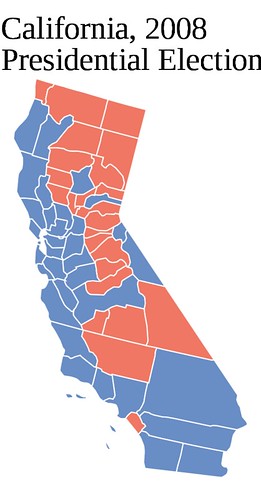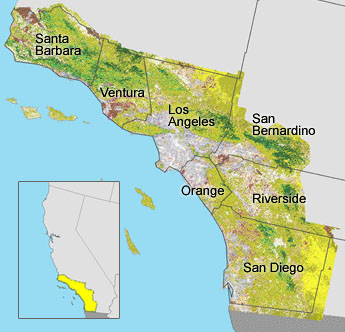This is the third part of a series of posts analyzing competitive Senate elections in blue states. It will focus on California. Because California is such a big and complicated state, it will have two sections – of which this is the first. The second part can be found here.
California, Section 1
In the greatest state of the union, a fierce senatorial battle is brewing. Former HP executive Carly Fiorina is mounting a tough challenge to incumbent Democrat Barbara Boxer. In an anti-Democratic national environment, polls show the race close and competitive. This post will examine the obstacles Ms. Fiorina will face as she seeks to overcome California’s formidable Democratic geography.
As America’s most populous state, California contains a number of distinct regions. This post, and the one following, will examine each.
More below.
Upper California and the Sierra Nevada
When people think of California, the northern forests and year-round snow of the Sierra Nevada generally do not come into mind. These regions, geographically expansive yet thinly populated, tend to vote loyally Republican (although until the 1970s Democrats had a base of support in several northeastern counties).
Not all of this region is Republican-voting, unpopulated wilderness. Exurban Placer County, for instance, contained 173,812 voters in 2008. Other parts – especially the liberal coast – tend to vote Democratic, eating in to Republican strength.
Ms. Fiorina will probably need something like 70% of the vote in places like Placer County to win. Strong margins from this Republican stronghold constitute the first, easiest step to a Republican victory.
The Bay Area
In many ways, the Bay Area is what makes California a blue state. Without the Bay Area, for instance, President George W. Bush would – almost – have won California in 2004, losing by a mere 0.7%.
Unfortunately for Republicans, the Bay Area – one of the richest, most diverse, and most liberal places in the country – does indeed exist, and it votes strongly Democratic. A popular attack against Senator Boxer is to call her a San Francisco liberal; this generally works less well in San Francisco.
In addition, voting habits in the Bay Area tend to be “sticky.” If the rest of California moves ten points more Republican, the Bay Area will tend to move only five points right. San Francisco and Alameda counties are sometimes the last two counties standing during Republican landslides.
There is a glimmer of hope for Republicans, however. The counties surrounding San Francisco and Berkeley tend to be one degree less intense in their liberalism. Ms. Fiorina will not win them, but a well-run campaign can reduce Democratic margins somewhat.
Central Valley
Home to some of the richest farmland in America, the counties composing Central Valley once leaned Democratic but now vote Republican in all but Democratic landslides. Conservative and heavily populated – although not by California standards – Central Valley provides somewhat of a reservoir to offset the enormous Democratic margins radiating from the Bay Area.
There is, however, one important exception: Sacramento, a populous county whose Democratic leanings deny Republicans a vast store of potential votes.
In the long run, Central Valley is a ticking time bomb. Democratic-voting Latinos compose 30-50% of the population in many of these counties, and their numbers will only increase. For now Ms. Fiorina is safe – Latinos do not vote their numbers, especially in mid-terms – but future Republicans cannot take Central Valley for granted.
The Challenge of Southern California
It is in the urban sprawl of SoCal, however, where Republicans face their greatest challenge. Ms. Fiorina has two tasks here. The first is to win the counties outside Los Angeles, and win them big. The second is to keep Los Angeles itself within single digits.
The next post will expand upon SoCal and offer a conclusion on Republican prospects of winning California.
–Inoljt, http://mypolitikal.com/



You say that it’s good for Fiorina if LA County is in single digits when the polls close. But the more liberal areas of the county tend to report later. IIRC Prop 8 was passing by double digits in LA County at first, same with props 16 and 17 back in June.
an diary about California. (School’s started up again and I’m too lazy to write anything about my own state.) And I love your section about the Bay Area where I live. Let me try to chip in some of my knowledge about the region.
Most of the people in the Bay Area to my knowledge live in the East Bay (Alameda, Contra Costa counties.) Also a majority of the black vote is concentrated on that side of the bay especially in Oakland, Richmond and the communities surrounding it. As you move east of Oakland, the population becomes whiter. This is most likely the case once you exit the east side of the Caldecott tunnel. Fiorina could attempt to eat away at Boxer’s margins along the eastern fringes of the Bay Area especially around Pleasanton, Concord, Walnut Creek.
On the other side of the bay you have San Francisco. Then you have the suburbs surrounding it. Rule of thumb if your measuring demographics in this area is the farther down 101/280 you go the population is less and less diverse until you hit San Jose. (The weather gets better too.) The communities, which are majority white aren’t as blue collar as their counterparts in the East Bay. Many of them commute to high tech jobs in Silicon Valley or the Financial District in San Francisco. These communities also have a strong sense of NIMBYism because they are fighting against the High Speed Rail project due to the fact it will not be buried underground, but placed on raised tracks.
(I don’t think any of the above helped that much, but I just wanted to put my experiences out there.)
in the area that knows her best (Silicon Valley) she is not well liked. Actually she is loathed by people from H-P, her former company. When you combine executive incompetence and greed, her spotty record of actually voting, and her issue positions outside the CA mainstream I just don’t see how she wins this election. She also does not come off as likable, which would help counter her issue positions (see Reagan, Ronald, for the counterexample). The last time that CA elected a Senator who was a fetal supremacist was back in the 1970s. We also tend to elect people who are at least somewhat supportive of environmental issues. One last thing about Carly; you know she will insert her foot in her mouth at least one more time before November.
Babs isn’t likely to win by 20 points again but I don’t see how Ms. Failorina manages to defeat her. The campaign is only getting started; Boxer is not yet up on the air.